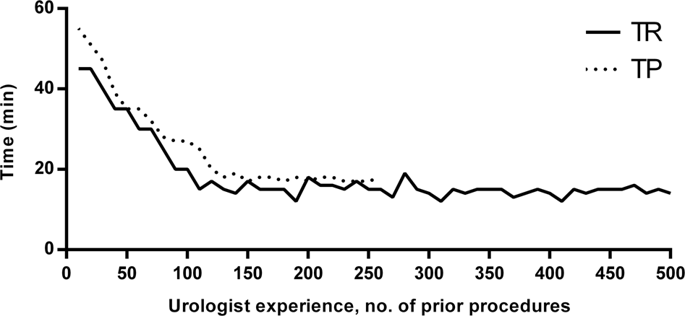Prostate Cancer and Prostatic Diseases ( IF 5.1 ) Pub Date : 2019-03-06 , DOI: 10.1038/s41391-019-0137-2 Daniel Halstuch 1 , Jack Baniel 1, 2, 3 , David Lifshitz 1, 2 , Sivan Sela 1 , Yaara Ber 1 , David Margel 1, 2, 3

|
Background
MRI-US fusion prostate biopsies are becoming a common procedure to diagnose prostate cancer. There is a paucity of information regarding the learning curve for fusion biopsies. We aim to study the amount of experience needed to be both accurate and time-efficient in this procedure.
Methods
We prospectively collected data on all MRI-US fusion biopsies performed from April 2014 to August 2017. We used two parameters to define the learning curve. Process Measurement (efficiency) was measured by time from the beginning of anesthesia to end of procedure. Outcome Measurement (accuracy) was measured by cancer detection rate for PI-RAD 3 lesions. The end of the learning curve was defined graphically and mathematically. We performed a separate analysis for transrectal and transperineal biopsies.
Results
We completed 779 fusion biopsies (523 transrectal, 256 transperineal). Patients median age was 66 years (IQR 61–70) and median PSA 6.95 ng/ml (IQR 4.2–10.6). Prostate cancer was diagnosed in 385 (49%). Process Measurement—Procedure time decreased from 45 min in the first transrectal fusion biopsy to 15 min after 109 biopsies and remained stable (p < 0.0001). Time decreased from 55 min in the first transperineal biopsy to 18 min after 124 biopsies (p < 0.0001). Outcome Measurement—In transrectal fusion-biopsies detection rate for PI-RADS 3 lesions increased from 35 to 50% after 104 biopsies. In transperineal fusion-biopsies, detection rate increased from 40 to 55% after 119 cases for PI-RADS 3 lesions.
Conclusions
We measured the learning curve of fusion biopsies graphically and mathematically. We demonstrated that proficiency occurs after 110 transrectal and 125 transperineal fusion-biopsies.
中文翻译:

表征 MRI-US 融合前列腺活检的学习曲线。
背景
MRI-US 融合前列腺活检正成为诊断前列腺癌的常用方法。关于融合活检的学习曲线的信息很少。我们的目标是研究在此过程中既准确又省时所需的经验量。
方法
我们前瞻性地收集了 2014 年 4 月至 2017 年 8 月进行的所有 MRI-US 融合活检的数据。我们使用两个参数来定义学习曲线。过程测量(效率)是通过从麻醉开始到手术结束的时间来测量的。结果测量(准确性)通过 PI-RAD 3 病变的癌症检出率来衡量。学习曲线的终点以图形和数学方式定义。我们对经直肠和经会阴活检进行了单独分析。
结果
我们完成了 779 例融合活检(523 例经直肠,256 例经会阴)。患者中位年龄为 66 岁(IQR 61-70),中位 PSA 为 6.95 ng/ml(IQR 4.2-10.6)。385 人 (49%) 被诊断出患有前列腺癌。过程测量——手术时间从第一次经直肠融合活检的 45 分钟减少到 109 次活检后的 15 分钟并保持稳定 ( p < 0.0001)。时间从第一次经会阴活检的 55 分钟减少到 124 次活检后的 18 分钟(p < 0.0001)。结果测量——在 104 次活检后,PI-RADS 3 病变的经直肠融合活检检出率从 35% 增加到 50%。在经会阴融合活检中,119 例 PI-RADS 3 病变的检出率从 40% 增加到 55%。
结论
我们以图形和数学方式测量了融合活检的学习曲线。我们证明熟练程度发生在 110 次经直肠和 125 次经会阴融合活检后。











































 京公网安备 11010802027423号
京公网安备 11010802027423号